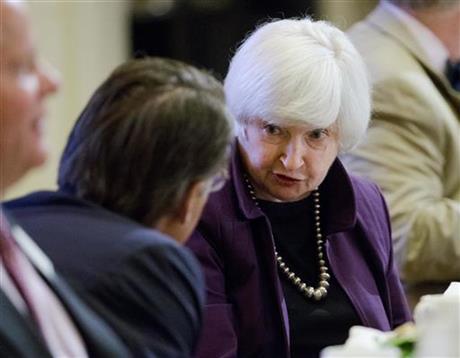- California Assembly OKs highest minimum wage in nation
- S. Korea unveils first graphic cigarette warnings
- US joins with South Korea, Japan in bid to deter North Korea
- LPGA golfer Chun In-gee finally back in action
- S. Korea won’t be top seed in final World Cup qualification round
- US men’s soccer misses 2nd straight Olympics
- US back on track in qualifying with 4-0 win over Guatemala
- High-intensity workout injuries spawn cottage industry
- CDC expands range of Zika mosquitoes into parts of Northeast
- Who knew? ‘The Walking Dead’ is helping families connect
Leaving rates alone, Fed sees ultra-slow pace of hikes ahead

In this Monday, June 6, 2016, file photo, Federal Reserve Chair Janet Yellen sits for lunch before making a scheduled speech in Philadelphia. Ending its latest policy meeting on Wednesday, June 15, the Federal Reserve issues a statement, updates its forecasts and holds a news conference with Yellen.
WASHINGTON (AP) — The Federal Reserve signaled Wednesday that it foresees an exceedingly slow pace of interest rate hikes ahead — and is in no hurry to resume them.
In explaining its decision to keep interest rates unchanged, the Fed expressed concern about a recent slump in U.S. job growth and about the potential consequences of Britain’s vote next week on whether to leave the European Union.
The Fed suggested in a statement after its latest policy meeting that it needs a clearer economic picture before resuming the rate hikes it began in December. It did note that the housing market is improving and that the consequences of an export slowdown have lessened. Yet it signaled concern about the uncertainty of employment growth and global developments.
Some economists think a July rate increase is possible if the job market rebounds from a dismal May and financial markets remain calm after Britain’s vote next week on whether to leave the European Union.
“There are too many uncertainties to justify pulling the trigger” now, said Sung Won Sohn, an economist at the University of California’s Martin School of Business. The Fed “wants to make sure that the surprisingly weak payroll number for May is a temporary phenomenon and not a harbinger of a weaker economy to come.”
In addition to the May jobs report, other economic barometers have also sowed doubts — from tepid consumer spending and business investment to a slowdown in worker productivity to stresses from China other major economies. And inflation remains below the Fed’s target.
The Fed raised its key policy rate modestly in December from a record low near zero, where it had been since the depths of the Great Recession in 2008. Its expectations for an even slower pace of rate hikes than earlier envisioned were contained in updated economic forecasts it issued Wednesday.
The forecasts show that among the 17 Fed policymakers, six think there will be only one rate hike this year, up from just one official who thought so at the Fed’s March meeting. Still, a majority of Fed officials continue to envision two rate hikes this year.
The officials’ expectations for rate hikes in future years slowed: Their median forecast shows just three hikes in 2017 and three in 2018, down from an expectation of four for each year. That change suggests that Fed officials remain concerned about a recovery that’s still sending mixed signals on jobs and inflation and that they’re comfortable that rates can be left ultra-low for longer.
The officials sounded a slightly more downbeat note about the economy’s growth this year and next compared with their forecasts three months ago. They now expect just 2 percent growth both this year and next year, down from their previous forecast of 2.2 percent for this year and 2.1 percent for 2017.
Stock investors had little reaction to the Fed’s statement. Stocks initially traded about where they were before the statement was released at 2 p.m. Eastern time before drifting modestly lower in late-afternoon trading. The yield on the benchmark 10-year Treasury note did edge down to 1.58 percent from 1.60 percent.
The Fed’s move to leave rates unchanged was approved 10-0. Esther George, head of the Federal Reserve Bank of Kansas City, who had dissented in earlier meetings because she favored faster rate hikes, backed Wednesday’s decision to keep rates unchanged.
For weeks, the Fed had been expected to consider raising rates at its June meeting. That view was encouraged by the minutes of its previous meeting in April. Those minutes suggested that a rate hike was likely if hiring and economic growth strengthened and inflation showed signs of accelerating toward the Fed’s 2 percent target rate.
But this month, the government caught the financial world off guard when it said employers added just 38,000 jobs in May— the weakest gain in five years — and that job growth averaged only 116,000 the past three months, down from 230,000 for the 12 months ending in April.
Suddenly, expectations for a rate hike this month declined. And some Fed watchers expressed confusion about the central bank’s approach to rates. Fed officials contend that they have long stressed that their rate policies are not on a pre-set course but rather are “data dependent.”
At a news conference Wednesday, Fed Chair Janet Yellen pointed to concern about the referendum next week in Britain over whether to leave the EU. A yes vote could roil markets, and the Fed wouldn’t likely want to further unnerve investors with a rate hike just a week before that vote.
Yellen acknowledged that the looming vote contributed to the Fed’s decision to leave rates unchanged.
“It was one of the factors,” she said at the news conference. The Fed chair also said the vote’s outcome could affect future rate decisions.
Though some economists think a July rate increase remains possible, others say the Fed’s economic outlook will still be too cloudy next month and are pointing to September as the most likely time for a Fed move.















